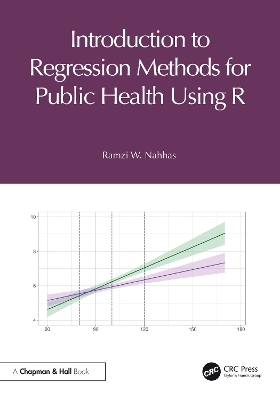
Introduction to Regression Methods for Public Health Using R
Seiten
2024
Chapman & Hall/CRC (Verlag)
978-1-032-20307-2 (ISBN)
Chapman & Hall/CRC (Verlag)
978-1-032-20307-2 (ISBN)
This book teaches regression methods for continuous, binary, ordinal, and time-to-event outcomes using R as a tool. Regression is a useful tool for understanding the associations between an outcome and a set of explanatory variables, and regression methods are commonly used in many fields.
Introduction to Regression Methods for Public Health Using R teaches regression methods for continuous, binary, ordinal, and time-to-event outcomes using R as a tool. Regression is a useful tool for understanding the associations between an outcome and a set of explanatory variables, and regression methods are commonly used in many fields, including epidemiology, public health, and clinical research. The focus of this book is on understanding and fitting regression models, diagnosing model fit, and interpreting and writing up results. Examples are drawn from public health and clinical studies. Designed for students, researchers, and practitioners with a basic understanding of introductory statistics, this book teaches the basics of regression and how to implement regression methods using R, allowing the reader to enhance their understanding and begin to grasp new concepts and models.
The text includes an overview of regression (Chapter 2); how to examine and summarize the data (Chapter 3), simple (Chapter 4) and multiple (Chapter 5) linear regression; binary, ordinal, and conditional logistic regression, and log-binomial regression (Chapter 6); Cox proportional hazards regression (survival analysis) (Chapter 7); handling data arising from a complex survey design (Chapter 8); and multiple imputation of missing data (Chapter 9). Each chapter closes with a comprehensive set of exercises.
Key Features:
Comprehensive coverage of the most commonly used regression methods, as well as how to use regression with complex survey data or missing data
Accessible to those with only a first course in statistics
Serves as a course textbook, as well as a reference for public health and clinical researchers seeking to learn regression and/or how to use R to do regression analyses
Includes examples of how to diagnose the fit of a regression model
Includes examples of how to summarize, visualize, table, and write up the results
Includes R code to run the examples
Introduction to Regression Methods for Public Health Using R teaches regression methods for continuous, binary, ordinal, and time-to-event outcomes using R as a tool. Regression is a useful tool for understanding the associations between an outcome and a set of explanatory variables, and regression methods are commonly used in many fields, including epidemiology, public health, and clinical research. The focus of this book is on understanding and fitting regression models, diagnosing model fit, and interpreting and writing up results. Examples are drawn from public health and clinical studies. Designed for students, researchers, and practitioners with a basic understanding of introductory statistics, this book teaches the basics of regression and how to implement regression methods using R, allowing the reader to enhance their understanding and begin to grasp new concepts and models.
The text includes an overview of regression (Chapter 2); how to examine and summarize the data (Chapter 3), simple (Chapter 4) and multiple (Chapter 5) linear regression; binary, ordinal, and conditional logistic regression, and log-binomial regression (Chapter 6); Cox proportional hazards regression (survival analysis) (Chapter 7); handling data arising from a complex survey design (Chapter 8); and multiple imputation of missing data (Chapter 9). Each chapter closes with a comprehensive set of exercises.
Key Features:
Comprehensive coverage of the most commonly used regression methods, as well as how to use regression with complex survey data or missing data
Accessible to those with only a first course in statistics
Serves as a course textbook, as well as a reference for public health and clinical researchers seeking to learn regression and/or how to use R to do regression analyses
Includes examples of how to diagnose the fit of a regression model
Includes examples of how to summarize, visualize, table, and write up the results
Includes R code to run the examples
Ramzi W. Nahhas teaches biostatistics at Wright State University, Dayton, Ohio, USA, where he is Professor in the Department of Population and Public Health Sciences, Boonshoft School of Medicine. In addition to teaching, he is actively involved in research collaborations with faculty, residents, and students, primarily in his own department and the Department of Psychiatry.
Preface 1. Introduction 2. Overview of Regression Methods 3. Data Summarization 4. Simple Linear Regression 5. Multiple Linear Regression 6. Binary Logistic Regression 7. Survival Analysis 8. Analyzing Complex Survey Data 9. Multiple Imputation of Missing Data Appendix A. Datasets Bibliography Index
| Erscheinungsdatum | 06.12.2024 |
|---|---|
| Zusatzinfo | 27 Tables, black and white; 45 Line drawings, color; 68 Line drawings, black and white; 45 Illustrations, color; 68 Illustrations, black and white |
| Sprache | englisch |
| Maße | 178 x 254 mm |
| Gewicht | 453 g |
| Themenwelt | Geisteswissenschaften ► Psychologie ► Allgemeine Psychologie |
| Mathematik / Informatik ► Mathematik ► Computerprogramme / Computeralgebra | |
| Studium ► Querschnittsbereiche ► Epidemiologie / Med. Biometrie | |
| Naturwissenschaften ► Biologie | |
| ISBN-10 | 1-032-20307-2 / 1032203072 |
| ISBN-13 | 978-1-032-20307-2 / 9781032203072 |
| Zustand | Neuware |
| Informationen gemäß Produktsicherheitsverordnung (GPSR) | |
| Haben Sie eine Frage zum Produkt? |
Mehr entdecken
aus dem Bereich
aus dem Bereich
ein überfälliges Gespräch zu einer Pandemie, die nicht die letzte …
Buch | Hardcover (2024)
Ullstein Buchverlage
24,99 €


